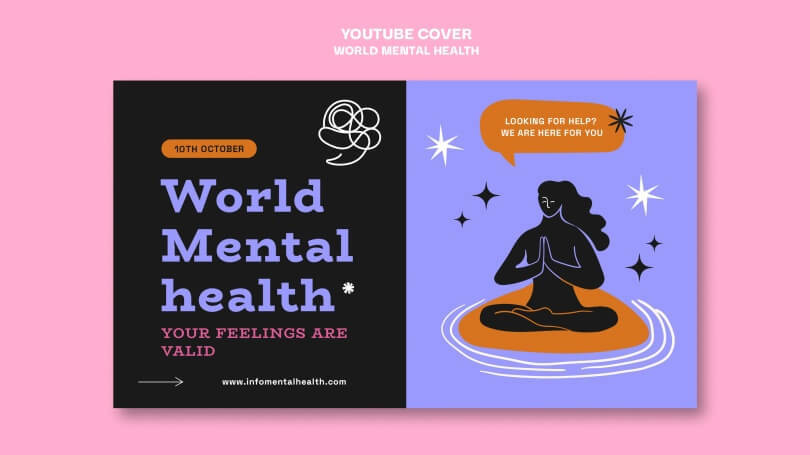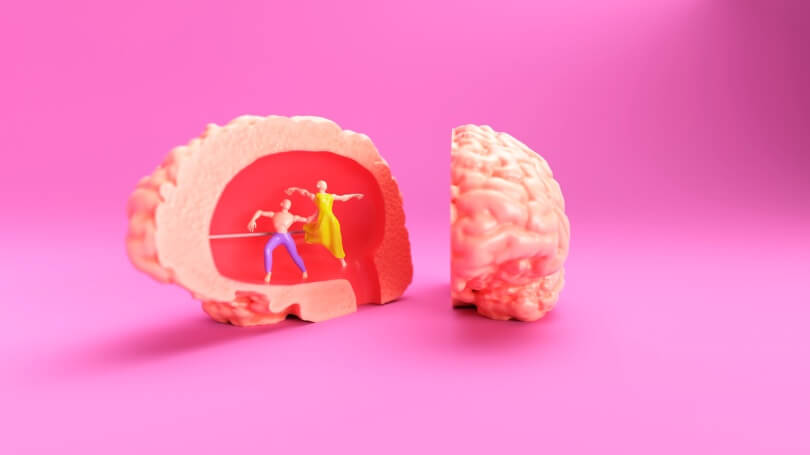Table of Contents
The Power of Visualization in Habit Change

Understanding the Subconscious Mind as a Blueprint for Behavior
Understanding the Subconscious Mind as a Blueprint for Behavior
The realm of the subconscious mind is a captivating expanse where the seeds of our behavior and habits are planted and meticulously nurtured. In the tapestry of human consciousness, it is often the unseen threads–the subconscious visualizations and mental imageries–that weave the most definitive patterns. Embracing the potent use of visualization techniques can serve as a master key to unlocking profound changes in our habits and behaviors.
Visualization Techniques and Habit Formation
Mental imagery or subconscious visualization has the unique capability to influence the neural pathways that dictate our behaviors. For instance, elite athletes often use visualization techniques to enhance their performance. They create vivid and detailed images of success in their minds–a race well-run, a routine perfectly executed, or a game-winning goal. This mental rehearsal embeds the desired outcomes into their subconscious, automating the behaviors needed to achieve them when it’s game time.
In the context of habit change, visualization tools can be equally effective. Picture yourself as someone who exercises daily. That mental picture is not just wishful thinking; research suggests that when you consistently visualize the actions and outcomes of a new habit, you prime your brain to act in alignment with the imagined scenarios. Visualization and habits are thus intricately linked in a dance of mental practice leading to real-world execution.
Subconscious Visualization for Everyday Success
Every action we take begins as a flicker in our subconscious–a passing thought or an image that our conscious mind may not immediately recognize. For example, envisioning a tidy work desk before falling asleep can subtly influence your behavior the next day, inclining you to organize your workspace without conscious thought. This subconscious visualization is not mere coincidence; it’s a manifestation of the power our mind holds in shaping our daily experiences.
The impacts are far-reaching, from overcoming anxiety to improving public speaking skills. Visualizing yourself confidently delivering a speech can minimize stage fright and prime your subconscious for success. By harnessing these visualization and habit strategies, we edge closer to achieving our personal and professional aspirations.
Embarking on a Journey of Subconscious Discovery
In unraveling the threads of our subconscious, we allow ourselves to reimagine the fabric of our existence with intricate and deliberate strokes. It suggests that by actively engaging in mental imagery, we can foster habit change and assert greater control over our behavior.
The application of this knowledge defies the bounds of theoretical musings–it’s a beacon for all seeking transformation through manageable, practical steps. Whether it is habit change or skill acquisition, the subconscious mind remains a fertile ground for growth, eternally ripe for the planting of new possibilities.
In conclusion, as we deepen our understanding of the profound connections between visualization techniques, mental imagery, subconscious visualization, and our behavioral blueprints, we unlock the potential for lasting, positive change. Thus, we shape not only our habits but forge our destiny – one visualized goal at a time.
Mental Imagery Techniques for Effective Habit Formation
The human psyche is a battlefield of conscious decisions and subconscious undercurrents, blending into a complex tapestry that defines our behavior. Among the most transformative elements of this psychic interplay are the connections between mental imagery, sometimes referred to as visualization techniques, and the process of habit change. This exploration delves into how the subconscious mind can be leveraged through visualization and habits to guide our personal development journey.
Unveiling the Subconscious Mind
The subconscious operates beneath the surface of our everyday awareness, tirelessly shaping our reactions, beliefs, and long-held behaviors. Subconscious visualization is a powerful method to influence this hidden realm, with individuals often unaware of the extent to which mental imagery molds their daily lives. By visualizing desired outcomes and the behaviors associated with them, one can reinforce positive habits and diminish the hold of negative patterns.
Consider the example of an athlete who spends time each day picturing the perfect execution of a skill. This mental rehearsal stimulates the same neural pathways as physical practice would, leading to improved performance without additional physical strain. Similarly, non-athletes can visualize themselves engaging in good habits such as healthy eating or regular exercise, thereby implicitly developing a preference for these actions.
Techniques of Mental Imagery for Habit Formation
Several visualization techniques have proven effective in habit formation. Engaging in daily visualization sessions where one vividly imagines executing a new habit can lay the groundwork for actual behavior change. It’s not just a matter of fleeting daydreams; this practice requires focused and repeated mental exercises that are as disciplined as physical training.
- Firstly, create a quiet, distraction-free environment to facilitate focused imagination.
- Secondly, employ all senses in the visualization process. The more detailed the imagery – incorporating sounds, sensations, and emotions – the more compelling and memorable it becomes.
- Lastly, pair this visualization with a consistent trigger, such as a particular time of day or after a routine task, to cement the habit in your daily schedule.
Integrating Visualization with Habit Change
The adoption of new habits can often be impeded by deeply ingrained subconscious resistance. To navigate this, habit change methods that include visualization can be particularly effective. By repeatedly imagining the successful completion of a habit, the mind becomes increasingly comfortable with this new behavior, making the transition from thought to action smoother and more natural.
To conclude, harnessing the power of the subconscious mind through deliberate and strategic visualization techniques has the potential to radically alter one’s behavior patterns and catalyze significant personal growth. Whether it’s for professionality, athleticism, or general well-being, embedding mental imagery in the routine of habit formation offers a potent tool for individuals committed to personal transformation. The key lies in consistency, sensory richness, and emotional engagement, transforming the practice from a passive pastime into an active method for life enhancement.
Strategies for Engaging the Subconscious in Daily Life

The Role of Repetition and Consistency in Habitual Growth
The intricate dance between our conscious desires and the powerhouse of the subconscious mind is pivotal in crafting the habits that constitute our daily life. In exploring the dynamics of habitual growth, it becomes clear that sheer repetition and consistency are the master keys to unlocking the enduring change we often seek.
The Hidden Might of Subconscious Visualization
Visualization techniques and mental imagery are not mere figments of imagination but essential tools wielded in the sculpting of new behaviors. The practice of subconscious visualization primes the neural pathways by vividly projecting desired outcomes as if they were part of our current reality. Habit change is then facilitated by a subtler form of repetition – one that takes place within the mind’s eye. Take for instance an athlete who visualizes crossing the finish line; such mental rehearsal augments physical training by engaging the subconscious mind where visualization and habits intertwine.
Crafting New Norms with Repetitive Actions
Solidifying new habits requires more than sporadic attempts; it demands the rhythm of ongoing practice. Consistency metamorphoses isolated actions into recognized patterns, fostering an environment where habit change becomes less of resistance and more of a return to a newfound normalcy. Consider the ritual of morning meditation. A sporadic session may offer transient peace, but it is through daily repetition that the mind rewires to naturally incline towards mindfulness as a habitual response to life’s stimuli.
- The reliability of daily practice instills routines deep into the fabric of our subconscious, beyond the reach of the fickle willpower.
- Every repeated action sends a signal that this behavior is to be prioritized, casting it eventually as a staple character trait rather than a passing phase.
- Cues and rewards tied to these actions fortify the habit loop, gradually transitioning conscious effort into subconscious orchestration.
Understanding that our subconscious mind works as a relentless scribe, documenting our most recurrent behaviors, it is evident that consistent repetition is the linchpin in crafting sustainable habits. Whether it is utilizing visualization techniques or engaging in the tangible act of doing, what we consistently reinforce becomes the script our subconscious mind follows. As we journey through the process of habit formation, let it be with the knowledge that our repeated actions are not just passing whispers to our brains, but potentially permanent etchings on the canvas of our identity.
Real-world Examples of Subconscious Mind Training for Habit Change
Understanding how the subconscious mind impacts our daily lives can unlock the potential for profound personal growth and habit change. Through the integration of visualization techniques and mental imagery, individuals are finding innovative ways to harness the power of subconscious visualization to transform their lives.
The Power of Visualization and Habits
At the heart of habit formation lies the intricate processes of our subconscious mind. It’s this part of our psyche that stores our automatic behaviors and responses. Visualization techniques become particularly effective here, as mental imagery stimulates the same neural networks that are involved in actual task performance. By repeatedly visualizing a particular behavior, the subconscious is trained to act in accordance with these mental rehearsals, crafting a bridge between desire and action. Athletes have been utilizing these techniques for decades, picturing the perfect swing or race to maximize their physical training. Today, similar visualization methods are applied by people from all walks of life to instigate positive habit change.
Subconscious Visualization in Action
Let’s consider the story of Sara, a pianist who struggled with stage fright. Despite her skill, the anxiety of performance inhibited her from reaching her full potential. By implementing subconscious visualization, she began to mentally rehearse her performances, picturing herself playing with confidence and receiving standing ovations. Over time, the edge of her stage fright dulled, as these positive visualizations fortified her mental fortitude and translated into a more confident stage presence.
In another example, Tom, a smoker for over 20 years, utilized visualization techniques to quit smoking. He imagined the sensations of being a non-smoker, visualizing his improved health and the taste of fresher air. These powerful subconscious cues complemented his physical efforts to quit, and eventually led to lastingly abandoning the habit.
Transformative Potential of Mental Imagery
For anyone looking to change a habit, subconscious visualization presents a compelling tool. Visualization and habits form an alliance that can reshape one’s routines and behaviors. This technique not only is backed by anecdotal evidence but is also underpinned by neuroscientific research, revealing that mental practices can enhance motivation, increase confidence and self-efficacy, improve motor performance, and prime the brain for success in real-world scenarios.
By utilizing visualization techniques, individuals craft detailed mental images of the habits they wish to adopt. This mental imagery serves as a blueprint, guiding the subconscious mind towards these new habits and behaviors. Each act of visualization reinforces the neural pathways necessary for the change, making the desired behavior more automatic and easier to adopt as part of one’s daily routine.
In summary, harnessing subconscious visualization can be a transformative strategy for anyone seeking to improve their life through habit change. By immersing into the vividness of mental imagery and cultivating a consistent practice, the subconscious mind can become a powerful ally in personal development and achieving lasting change.
Summary
The Power of Visualization in Habit Change is a compelling approach to fostering new habits and behaviors. By employing visualization techniques and mental imagery, we can tap into our subconscious visualization capabilities to facilitate habit change. These methods are not mere exercises in creativity but are grounded in neuroscience and psychology, showing that visualization can prime our behavioral responses and lead to meaningful changes in our daily lives.
Unlocking Behavioral Change Through Visualization
Visualization techniques act as a bridge between the desire for a new habit and the actual practice of it. When we visualize ourselves performing a new behavior – be it perfecting a sports move or engaging in healthy eating – we’re rehearsing success and solidifying neural pathways, making real-world execution more natural. This mental practice of visualization and habits is crucial for athletes and non-athletes alike, offering a powerful tool for those committed to personal change.
- Mental rehearsal stimulates neural circuits that are also activated during the actual behavior, strengthening our ability to perform the behavior.
- Visualizing success embeds desired outcomes into the subconscious, effectively programming our minds to act in alignment with our goals.
- Consistent visualization, when paired with triggers, can reform and establish new habits within our daily routines.
For instance, an athlete may improve their performance by repeatedly visualizing themselves winning a race, which reinforces the behavior in their subconscious. Similarly, someone aiming to quit smoking can use subconscious visualization to imagine a healthier lifestyle, tangibly aiding their journey to becoming smoke-free.
By consistently marrying the act of visualization with our routines, we can influence our subconscious minds to embrace new habits. This strategy not only paves the way for the acquisition of desired behaviors but also shapes long-term character traits that define who we are.
Subconscious visualization is no longer a concept reserved for theoretical discourse; it has become a practical method for life enhancement. When employed regularly, it has the potential to not just instigate habit change but also to redefine our daily experiences and unlock our transformative potential. Through mental imagery, we craft rich, detailed visualizations that guide the subconscious toward these new behaviors, effectively sculpting the future one visualized goal at a time.
Embrace the power of your mind and the profound impact it has on your behavior. Harnessing the intricacies of subconscious visualization and mental imagery can lead to profound personal growth and the development of healthy, long-lasting habits. Visualization is an undeniable force, weaving the fabric of our desired destiny with every vivid image cast in the depths of our minds.
FAQ – The Power of Visualization in Habit Change
How can mental imagery and subconscious visualization be effectively utilized to reinforce the development of new habits?
Mental imagery and subconscious visualization tap into our brain’s ability to simulate experiences, creating a fertile ground for new habits to take root. By vividly picturing ourselves performing a desired behavior, we strengthen neural pathways associated with that action, making it more likely for the habit to form in real life. For instance, a person aiming to adopt a daily exercise routine can regularly envision themselves enjoying a workout, which can increase motivation and make the actual activity feel more natural and rewarding.
How does utilizing mental imagery and subconscious visualization during habit formation improve the likelihood of establishing long-term behavioral change?
Utilizing mental imagery and subconscious visualization taps into the brain’s innate ability to simulate experiences, creating a powerful rehearsal process that enhances learning and the establishment of new neural pathways critical for habit formation. By vividly imagining desired behaviors, individuals reinforce their mental and emotional connection to the actions, significantly increasing the likelihood of consistent practice and long-term behavior change, akin to an athlete visualizing a successful performance to boost actual execution.
How does mental imagery enhance the process of habit formation and consolidation in the brain?
Mental imagery engages the brain in a rehearsal of the desired behavior, forging neural pathways similar to those created during actual performance, thereby strengthening the habit’s formation. By vividly picturing ourselves executing a new routine, such as a morning run, we enhance the brain’s ability to encode this practice into the subconscious, making it more automatic and less reliant on conscious effort over time. This cognitive process effectively molds the brain’s plasticity to support and consolidate new habits, facilitating a smoother transition from intention to habitual action.




